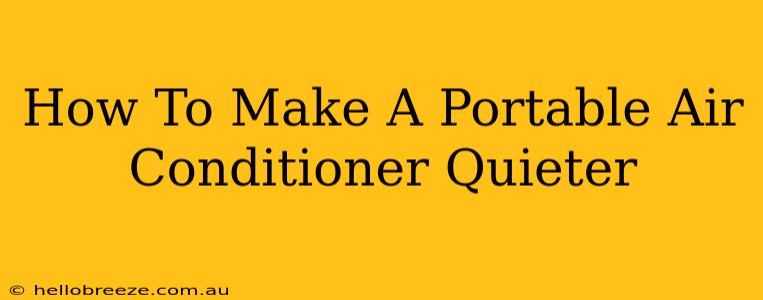Portable air conditioners are lifesavers during those scorching summer months, but their noise levels can sometimes be a major drawback. That constant hum can disrupt sleep, conversations, and overall peace and quiet. Luckily, there are several ways to significantly reduce the noise produced by your portable AC unit. This guide will walk you through practical solutions to make your portable air conditioner quieter, allowing you to enjoy cool comfort without the unwanted noise.
Understanding the Sources of Portable AC Noise
Before diving into solutions, it's helpful to understand what creates the noise in the first place. Most of the sound comes from a few key sources:
- Compressor: The compressor is the heart of the AC unit, responsible for circulating refrigerant. It's the primary source of the humming and rumbling sounds.
- Fan: The fan motor and blades contribute to a significant portion of the noise, especially on higher settings.
- Vibrations: The entire unit can vibrate, transferring noise to surrounding surfaces. This is often exacerbated by uneven surfaces or loose components.
- Airflow: The movement of air itself can create noise, particularly when the air is forced through vents or restricted pathways.
Effective Ways to Reduce Portable AC Noise
Now that we know the culprits, let's explore effective strategies to quiet your portable air conditioner:
1. Strategic Placement is Key
- Solid Surface: Place your portable AC unit on a solid, level surface. Avoid placing it on carpet or rugs, as these absorb vibrations poorly and amplify noise. A solid floor or a sturdy, flat table is ideal.
- Away from Walls: Keep the unit away from walls and corners. Positioning it against a wall can reflect sound and increase the perceived noise level. A little space allows for better air circulation and reduces vibrations transferred to the wall.
- Reduce External Noise: Minimize other sound sources in the immediate area. This simple step can make a big difference in the overall noise perception. Think about removing noisy objects or closing doors to reduce external noise distractions.
2. Sound Dampening Techniques
- Rubber Mats or Pads: Placing rubber mats or anti-vibration pads under the unit can absorb vibrations and significantly reduce the noise transfer to the floor. These are inexpensive and readily available at most hardware stores.
- Sound-Absorbing Materials: Consider placing sound-absorbing materials, like thick blankets or acoustic foam panels, around the unit. This will help to absorb the sound waves generated by the compressor and fan. However, ensure adequate ventilation to prevent overheating.
- Insulation: If you're handy, you might consider adding additional insulation around the unit's casing. This will help to dampen vibrations and reduce noise, but it's a more involved solution and requires careful consideration to ensure proper ventilation.
3. Maintenance and Regular Cleaning
- Clean the Filters: Regularly cleaning or replacing the air filters is crucial for maintaining efficient airflow and reducing noise. Clogged filters restrict airflow, causing the fan to work harder and generate more noise.
- Check for Loose Parts: Make sure all parts of the unit are securely fastened. Loose screws or components can vibrate and create additional noise. Tighten any loose screws or parts to eliminate unnecessary rattling.
4. Consider White Noise Machines or Fans
If you're still experiencing excessive noise despite these adjustments, consider using white noise machines or fans to mask the sound of the air conditioner. White noise can effectively cover up the hum of the AC unit, creating a more peaceful atmosphere.
Choosing a Quieter Portable AC Unit (For Future Purchases)
If you're planning to purchase a new portable air conditioner, pay close attention to the decibel (dB) rating. Lower decibel ratings indicate quieter operation. Many manufacturers now specify the noise level in their product specifications. Also, consider reading reviews to gauge users' experiences with noise levels.
By implementing these strategies, you can significantly reduce the noise produced by your portable air conditioner and enjoy the cool comfort without the constant hum. Remember, a combination of the methods described above often yields the best results. Choose the ones that best fit your circumstances and budget to create a more peaceful and comfortable living environment.

